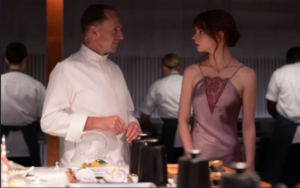THE MENU: 4 STARS. “about the passion of the artist and what happens when it fades.”
 “The Menu,” a new dark comedy starring Anya Taylor-Joy and Ralph Fiennes and now playing in theatres, pokes fun at the kind of pretentious restaurant experience where customers, willing to pay $1,250 a head for a tasting menu prepared by a famous chef, aren’t diners, but “ingredients in a degustation concept.”
“The Menu,” a new dark comedy starring Anya Taylor-Joy and Ralph Fiennes and now playing in theatres, pokes fun at the kind of pretentious restaurant experience where customers, willing to pay $1,250 a head for a tasting menu prepared by a famous chef, aren’t diners, but “ingredients in a degustation concept.”
Renowned Chef Slowik’s (Ralph Fiennes) farm-to-table restaurant Hawthorne, situated on its own, remote 12-acre island, is a hot ticket, seating only 12 people a night. The celebrity chef oversees a brigade of highly trained cooks who diligently create artfully composed haute cuisine plates with names bigger than the actual portion sizes. He’s the anti-Guy Fieri, a chef who thinks of food as an intellectual exercise rather than nourishment.
The guestlist for the night’s exclusive dinner is an eclectic grab bag of rich and famous folks. From a movie star (John Leguizamo) and a haughty food writer (Janet McTeer) and her editor (Paul Adelstein) to Anne and Richard (Judith Light and Reed Birney), a rich couple who have been regulars at the restaurant for years and a troika of obnoxious tech bro one percenters (Rob Yang, Mark St. Cyr and Arturo Castro) who toast to “work and money,” they are all under the spell of Chef Slowik. All except Margot (Taylor-Joy), the last-minute date of foodie and Slowik super-fan Tyler (Nicholas Hoult). “Slowik is not just a chef,” says Tyler breathlessly, “he’s a storyteller.”
There are rules to dining at Hawthorne. No photographs. “Chef strongly believes the beauty of the food lies in its ephemeral nature,” says the restaurant’s stern host Elsa (Hong Chau). Also, don’t eat. What? “Taste. Savor. Relish,” commands the chef. “Consider every morsel you place in your mouth. Do not eat. Our menu is too precious for that.”
In a bit of unintentional foreshadowing, Tyler scans the room and announces, “It’s official. Tonight will be madness.”
“The menu and the night,” the chef announces, “has been painstakingly planned.” Before each course Chef Slowik, who Margot sarcastically refers to as the Lord High Emperor of Sustenance, provides a flowery description of the food about to be served. As the evening wears on, chef’s descriptions become increasingly philosophical. Tensions rise in the room as the chef’s food reveals as much about the people eating it as it does about the chef’s intentions.
“The Menu” is for anyone who creates art—whether it is food, writing, paintings, whatever the form—and feels underappreciated. Slowik takes his delicious revenge on the patrons who “drained the mystery from my art” with their arrogance and entitlement, or worse, committing the cardinal sin of asking for a substation on one of his carefully constructed plates. He is done, he says, “trying to satisfy people who can’t be satisfied.”
Like the recent “Triangle of Sadness” the victims of the movie are oblivious, wealthy people who hide behind their wallets. The world, Slowik says, is divided into two groups, those who give—he and his service industry colleagues—and those who take. His elaborate menu is his gruesome retaliation on the latter.
A heaping helping of suspension of disbelief is required to enjoy the satire of “The Menu,” but by the time it makes its intentions clear, the film sates the appetite for dark comedy. It’s as subtle as fermented Surströmming (look it up) but this mix of horror and humor has more to offer than shock value. Food for thought on how art is consumed (literally in this case), it’s about the passion of the artist and what happens when it fades.
“The Menu” is buoyed by terrific performances, particularly from Fiennes as the perfectionist chef and Taylor-Joy as the pragmatic Margot, but most importantly, because all the characters are as sour as vinegar, you never quite know where the story is going. That unpredictability is exciting, leaving the characters, and the audience, walking on eggshells.
